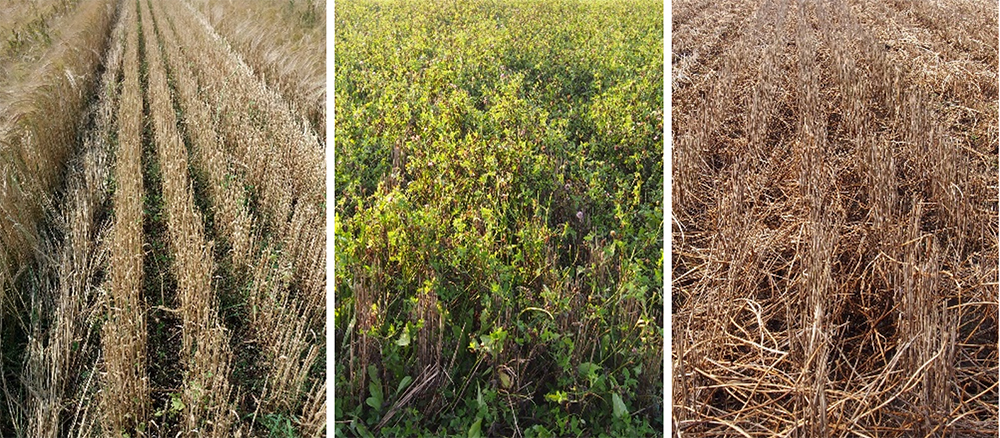Residual nitrogen effect of cover crops and straw by different crop management
Residues from both main crops and cover crops may play an important role in the nutrient recycling. Despite of very different visible cover crop biomass in two years, the residual nitrogen fertiliser value of a clover-containing cover crop was consistently high.
By Doline Fontaine, Jørgen Eriksen and Peter Sørensen. Department of Agroecology, Aarhus University.

As part of the NutHY project, field experiments were repeated in two other years to study effects of the main crop harvest management on the performance and residual fertiliser effect of an under-sown cover crop. The main objective was to investigate the effect of harvest time, cutting height of straw and straw removal from the main crop on cover crop growth, composition, uptake and N fertilizer replacement value (NFRV) in the following crop. In addition, the study quantified the effect of cover crop harvest in autumn on the residual N value.
The growth of undersown cover crops is limited when the main crop biomass becomes dense due to restrictions to light access. However, the growth is resumed after the harvest of the main crop. Early harvest of cereals for animal feed could prolong the vegetative period of the cover crop. In addition, harvest with a high stubble of straw can affect the cover crop growth and the residual N.
Cover crop shoots and straw residues can be directly incorporated in the field or harvested in autumn as mobile green manure, and e.g. used as input in a biogas plant.
Cover crop root residues contribute to a stable and high nitrogen fertiliser value
We used an under-sown cover crop mixture consisting of red clover, ryegrass and chicory in our study. Clover dominated in the cover crop mixture (92% and 61% of the total biomass yield), but its growth was affected by climatic condition (low rainfall in spring and autumn).
Early harvest of barley did not affect the biomass yield of the under-sown cover crops. Early harvest was carried out 2 weeks before barley maturity. During this period, limited precipitation and high temperature contributed to a rapid evaporation, not suitable for the resumption of cover crop growth.
The N supply to the following crop from the root biomass was independent of the cover crop shoot yield. Despite substantial difference of cover crop yields between years, the NFRV of root residues was more constant (44-51 kg N ha-1, Table 1). The NFRV of top residues left on the field were equivalent to 21 kg N ha-1 of mineral fertilizer in average. Therefore, root residues contributed mostly to the N uptake of the succeeding crop (65 to 75% of the total NFRV).
High stubble of straw left standing after the early harvest of the upper parts, rapidly decomposed with a 62% weight loss after 3 months. Yet, the incorporation of the high stubble of straw in the following spring reduced the NFRV by up to 20%.

In conclusion, we found a significant residual N fertilizer value of an N-fixing cover crop even after a year with moderate above-ground biomass of the cover crop. Furthermore, the contribution of root residues to the N supply of the following crop should not be underestimated even in years where cover crop shoot biomass is less developed.